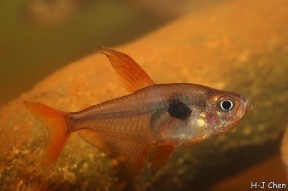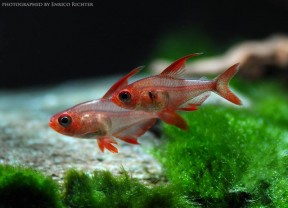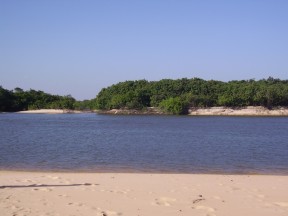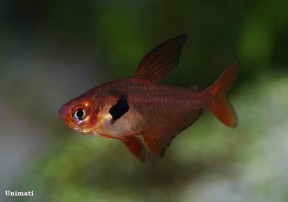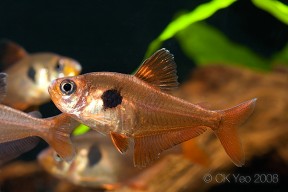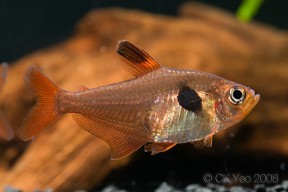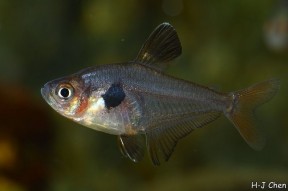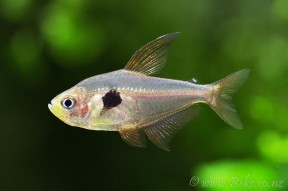Hyphessobrycon sweglesi
Red Phantom Tetra
SynonymsTop ↑
Megalamphodus sweglesi Géry, 1961
Etymology
Hyphessobrycon: from the Ancient Greek υπελάσσων (hyphésson), meaning ‘of lesser stature’, used as a prefix in this case, plus the generic name Brycon.
sweglesi: named in honour of tropical fish distributor Kyle Swegles (Rainbow Aquarium, Chicago, Illinois, USA), who collected the type series.
Classification
Order: Characiformes Family: Characidae
Distribution
Endemic to the upper and middle Río Orinoco watershed in Colombia (departments of Meta, Casanare, Arauca, Vichada, and Guainía) and Venezuela (states of Amazonas, Apure, Guárico, and Bolivar). It has been collected from several major tributaries including the ríos Atabapo, Guaviare, Inirida, Ventauri, Meta, Cinaruco, Arauca, Apure, Capanaparo, and Caura.
Type locality was originally given as ‘Leticia, Peru’, but later corrected to ‘Río Muco, upper Río Orinoco basin, Colombia’ by Géry (1966).
Habitat
Apparently favours minor tributaries, smaller rivers, oxbows, and flooded forests rather than main river channels.
It occurs throughout the vast llanos regions of Colombia and Venezuela, and in the latter country is often associated with habitats known as morichals which tend to contain transparent, clear water and sandy substrates, often with dense growth of aquatic plants or riparian vegetation among which the fish take shelter.
In other parts of its range it has been collected from both flowing blackwater habitats and still floodplain lakes, while the majority of rivers and wetlands across its range are subject to extreme flooding during the annual rainy season.
One example of a natural habitat is the Río Cinaruco, a low nutrient, blackwater tributary of the Orinoco in southwestern Venezuela which comprises a meandering river channel with numerous interconnected lagoons and floodplain lakes.
The latter two biotope-types feature reduced water flow, increased turbidity and temperature, a greater accumulation of leaf litter, and higher densities of zooplankton than the main channel.
Other fishes occurring in the Río Orinoco basin and available in the trade include Corydoras delphax, Platydoras costatus, Baryancistrus beggini, Hypancistrus inspector, Panqolus maccus, Panaque nigrolineatus, Hemigrammus rhodostomus, H. stictus, Paracheirodon axelrodi, Pristella maxillaris, Copella nattereri, Biotodoma wavrini, Heros severus, Mesonauta insignis, Satanoperca daemon and Uaru fernandezyepezi.
Maximum Standard Length
30 – 35 mm.
Aquarium SizeTop ↑
An aquarium with base dimensions of 80 ∗ 30 cm or equivalent should be the smallest considered.
Maintenance
Perhaps looks best in an arrangement comprising a sandy substrate plus some driftwood roots and branches, or heavily-planted planted set-up.
The addition of dried leaf litter would further emphasise the natural feel and as well as offering additional cover for the fish brings with it the growth of microbe colonies as decomposition occurs.
The latter are useful since they provide an additional food source for both adults and fry while the humic substances released by decaying leaves are also considered beneficial.
Water Conditions
Temperature: 20 – 28 °C
pH: 4.5 – 7.5
Hardness: 18 – 215 ppm
Diet
Likely to be omnivorous feeding on small invertebrates, crustacea, filamentous algae, fallen fruit and suchlike in nature.
In aquaria it may survive on a diet of dried foods but like most fishes does best when offered a varied menu which in this case should also contain live and frozen chironomid larvae (bloodworm), mosquito larvae, Daphnia, Moina, etc.
Behaviour and CompatibilityTop ↑
Very peaceful making it an ideal resident of the well-researched community aquarium.
It is perhaps best-maintained alongside similarly-sized characids, gasteropelecids, lebiasinids, smaller callichthyid or loricariid catfishes and non-predatory, small-to-medium-sized cichlids.
Try to buy a mixed-sex group of at least 8-10 specimens since this species forms temporary dominance hierarchies within which males compete for female attention, and therefore displays more interesting behaviour and better colouration when maintained in numbers.
Sexual Dimorphism
Adult males develop extended dorsal and anal fins, while females are deeper-bodied.
Reproduction
An egg-scattering free spawner exhibiting no parental care.
When in good condition adults will spawn often and in a mature aquarium it is possible that small numbers of fry may start to appear without intervention, but if you want to maximise yield a more controlled approach is required.
The adult group can still be conditioned together but a smaller aquarium should also be set up and filled with mature water. This should be very dimly lit and the base covered with some kind of mesh of a large enough grade so that the eggs can fall through but small enough so that the adults cannot reach them. The widely available plastic ‘grass’-type matting can also be used and works well, as does a layer of glass marbles. Alternatively, filling much of the tank with a fine-leaved plant such as Taxiphyllum spp. or spawning mops can also return decent results.
The water itself should be of slightly acidic to neutral pH with a temperature towards the upper end of the range suggested above. An air-powered sponge filter or air stone(s) should also be included to provide oxygenation and water movement.
When the adult fish are well-conditioned a single pair or group comprising one or two males and several females can then be introduced to each container and left in place until eggs are detected (typically the following morning).
Initial food should be Paramecium or a proprietary dry food of sufficiently small (5-50 micron) grade, introducing Artemia nauplii, microworm, etc., once the fry are large enough to accept them.
NotesTop ↑
This small species is a popular aquarium fish and is bred on a commercial basis in several countries, with wild fishes relatively scarce in the ornamental trade.
At least two or three colour forms have been traded, of which one is particularly colourful and has been referred to as H. sweglesi ‘red’ or ‘var. rubra’. The bright red pigmentation is retained in long-term captive specimens, suggesting that it is not an artefact of diet, but we suspect it might reflect conditions at the collection locality with the reddest fish putatively inhabiting blackwater and plainer forms clearwater environments. Zarske (2014) found the two forms to be identical in terms of morphology and meristics and therefore concluded that they are conspecific.
Following the most recent diagnosis by Zarske (2014), H. sweglesi can be diagnosed by the following combination of characters: body relatively shallow, its depth fitting 2.71-2.90 times in its SL; an irregular row of 9-10 premaxillary teeth; 3-6 maxillary teeth; 22-25 branched anal-fin rays; 31-33 longitudinal scales; 5/1/3-4 predorsal scales; sexual dimorphism evident in shape of dorsal and anal fins; humeral spot relatively large.
H. sweglesi was originally described as a member of the genus Megalamphodus Eigenmann 1915, which was diagnosed by possession of only a single row of teeth. This was synonymised with Hyphessobrycon by Weitzman and Palmer (1997) who found that some individuals of M. megalopterus, the type species, and the related M. micropterus possessed two rows of teeth as in some members of their ‘rosy tetra’ group (see below). In addition, most of the species formerly included in Megalamphodus display other characters associated with this putative assemblage, most obviously a dark humeral spot plus a similarly-coloured marking in the dorsal-fin.
Hyphessobrycon was raised by Durbin in Eigenmann (1908) as a subgenus of Hemigrammus, differing from the latter by the absence of scales on the caudal-fin.
The grouping was revised by Eigenmann (1918, 1921) while Géry (1977) created artificial groups of species based on colour pattern, and these definitions are still widely used today, e.g., the H. agulha group, the H. heterohabdus group, etc. These cannot be considered to represent monophyletic assemblages, however, and their concepts continue to be redefined.
Weitzman & Palmer (1997) hypothesised the existence of a monophyletic assemblage within the genus based on colour pattern and male fin morphology that they termed the ‘rosy tetra clade’, with one of the characters supporting its monophyly being presence of a prominent dark marking on the dorsal-fin. This assemblage, plus other morphologically similar species, is considered to represent Hyphessobrycon sensu stricto by some authors, with the remaining species included in a much-expanded H. heterohabdus group.
Others have proposed conflicting, typically more restricted, views of both the genus and/or its constituent species groups, and significant confusion remains. What is clear is that, as currently recognised, Hyphessobrycon is a polyphyletic lineage containing several genera.
The process of splitting it up has already started, and Malabarba et al. (2012) revalidated the genus Ectrepopterus Fowler, previously considered a synonym of Hyphessobrycon. They also analysed its relationships within the Characidae in the context of Mirande’s (2010) previous work, but included the type species, H. compressus, for the first time in such a study. The results demonstrated that H. compressus is more closely-related to ‘rosy tetra’ representatives such as H. eques, H. pulchripinnis, and H. socolofi than other members of the genus including H. anisitsi, H. bifasciatus, H. elachys, H. herbertaxelrodi, and H. luetkeni.
References
- Géry, J., 1966 - Ichthyologica, the Aquarium Journal 37(5): 211-236
A review of certain Tetragonopterinae (Characoidei), with the description of two new genera. - Calcagnotto, D., S. A. Schaefer, and R. DeSalle, 2005 - Molecular Phylogenetics and Evolution 36(1): 135-153
Relationships among characiform fishes inferred from analysis of nuclear and mitochondrial gene sequences. - Géry, J., 1977 - T. F. H. Publications, Inc.: 1-672
Characoids of the world. - Géry, J., 1961 - Tropical Fish Hobbyist 9(9): 26-46
Three new South – American Characids: Knodus savannensis, Hyphessobrycon herbertaxelrodi and Megalamphodus sweglesi, with a review of some Hyphessobrycon - group of species. - Lasso, C. A., D. Lew, D. Taphorn, C. DoNascimiento, O. Lasso-Alcalá, F. Provenzano, and A. Machado-Allison, 2004 - Memoria de la Fundación La Salle de Ciencias Naturales 159-160: 105-195
Biodiversidad ictiológica continental de Venezuela. Parte I. Lista de especies y distribución por cuencas. - Malabarba, L. R., V. A. Bertaco, F. R. Carvalho & T. O. Litz., 2012 - Zootaxa 3204: 47-60
Revalidation of the genus Ectrepopterus Fowler (Teleostei: Characiformes), with the redescription of its type species, E. uruguayensis. - Mirande, J. M., 2010 - Neotropical Ichthyology 8(3): 385-568
Phylogeny of the family Characidae (Teleostei: Characiformes): from characters to taxonomy. - Oliveira, C. A., G. S. Avellino, K. T. Abe, T. C. Mariguela, R. C. Benine, G. Orti, R. P. Vari, and R. M. Corrêa e Castro, 2011 - BMC Evolutionary Biology 11(1): 275-300
Phylogenetic relationships within the speciose family Characidae (Teleostei: Ostariophysi: Characiformes) based on multilocus analysis and extensive ingroup sampling. - Reis, R. E., S. O. Kullander and C. J. Ferraris, Jr. (eds), 2003 - EDIPUCRS, Porto Alegre: i-xi + 1-729
Check list of the freshwater fishes of South and Central America. CLOFFSCA. - Taphorn P., D. C., 1992 - Biollania Edición Especial - No. 4. Monografias Cientificas del Museo de Ciencias Naturales, UNELLEZ - Guanara, estado Portuguesa, Venezuela: 1-537
The characiform fishes of the Apure River drainage, Venezuela. - Weitzman, S. H. and L. Palmer, 1997 - Ichthyological Exploration of Freshwaters 7(3): 209-242
A new species of Hyphessobrycon (Teleostei: Characidae) from the Neblina region of Venezuela and Brazil, with comments on the putative `rosy tetra clade'. - Zarske, A., 2014 - Vertebrate Zoology 64(2): 139-167
Zur Systematik einiger Blutsalmler oder "Rosy Tetras" (Teleostei: Ostariophysi: Characidae).
